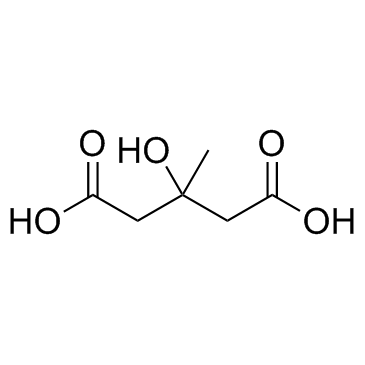3-hydroxy-3-methylglutaric acid

3-hydroxy-3-methylglutaric acid structure
|
Common Name | 3-hydroxy-3-methylglutaric acid | ||
|---|---|---|---|---|
| CAS Number | 503-49-1 | Molecular Weight | 162.14100 | |
| Density | 1.417 g/cm3 | Boiling Point | 120 °C / 13mmHg | |
| Molecular Formula | C6H10O5 | Melting Point | 105-108 °C(lit.) | |
| MSDS | Chinese USA | Flash Point | 182.2ºC | |
|
NMR spectroscopic studies on the late onset form of 3-methylglutaconic aciduria type I and other defects in leucine metabolism.
NMR Biomed. 19(2) , 271-8, (2006) A diagnosis of 3-methylglutaconic aciduria type I (OMIM: 250950) based on elevated urinary excretion of 3-methylglutaconic acid (3MGA), 3-methylglutaric acid (3MG) and 3-hydroxyisovaleric acid (3HIVA) was made in a 61-year-old female patient presenting with l... |
|
|
Unimolecular reaction chemistry of a charge-tagged beta-hydroxyperoxyl radical.
Phys. Chem. Chem. Phys. 16(45) , 24954-64, (2014) β-Hydroxyperoxyl radicals are formed during atmospheric oxidation of unsaturated volatile organic compounds such as isoprene. They are intermediates in the combustion of alcohols. In these environments the unimolecular isomerization and decomposition of β-hyd... |
|
|
Mitochondrial DNA depletion associated with partial complex II and IV deficiencies and 3-methylglutaconic aciduria.
J. Child Neurol. 16(2) , 136-8, (2001) We report a patient with mitochondrial DNA depletion, partial complex II and IV deficiencies, and 3-methylglutaconic aciduria. Complex II deficiency has not been previously observed in mitochondrial DNA depletion syndromes. The observation of 3-methylglutacon... |
|
|
Induction of oxidative stress by the metabolites accumulating in 3-methylglutaconic aciduria in cerebral cortex of young rats.
Life Sci. 82(11-12) , 652-62, (2008) 3-methylglutaconic (MGT), 3-methylglutaric (MGA) and occasionally 3-hydroxyisovaleric (OHIVA) acids accumulate in a group of diseases known as 3-methylglutaconic aciduria (MGTA). Although the clinical presentation of MGTA is mainly characterized by neurologic... |
|
|
Neurochemical evidence that 3-methylglutaric acid inhibits synaptic Na+,K+-ATPase activity probably through oxidative damage in brain cortex of young rats.
Int. J. Dev. Neurosci. 29(1) , 1-7, (2011) 3-Methylglutaconic aciduria (MGTA) comprehends a group of disorders biochemically characterized by accumulation of 3-methylglutaric acid (MGA), 3-methylglutaconic acid (MGT) and occasionally 3-hydroxyisovaleric acid (OHIVA). Although neurological symptoms are... |
|
|
3-methyglutaconic aciduria in a Chinese patient with glycogen storage disease Ib.
J. Inherit. Metab. Dis. 26(7) , 705-9, (2003) We report elevated urinary excretion of 3-methylglutaconic (3MGC) and 3-methylglutaric acids (3MGR) in a patient with glycogen storage disease Ib. Combined excretion was 10-fold elevated in comparison to control during inadequate glucose maintenance, and stil... |
|
|
Striatum is more vulnerable to oxidative damage induced by the metabolites accumulating in 3-hydroxy-3-methylglutaryl-CoA lyase deficiency as compared to liver.
Int. J. Dev. Neurosci. 27(4) , 351-6, (2009) The present work investigated the in vitro effects of 3-hydroxy-3-methylglutarate, 3-methylglutarate, 3-methylglutaconate and 3-hydroxyisovalerate, which accumulate in 3-hydroxy-3-methylglutaric aciduria, on important parameters of oxidative stress in striatu... |
|
|
Carboxylated hyperbranched poly(glycidol)s for preparation of pH-sensitive liposomes.
J. Control. Release 149(1) , 72-80, (2011) Previous reports by the authors described intracellular delivery using liposomes modified with various carboxylated poly(glycidol) derivatives. These linear polymer-modified liposomes exhibited a pH-dependent membrane fusion behavior in cellular acidic compar... |
|
|
3-Methylglutaric acid as a 13C solid-state NMR standard.
Solid State Nucl. Magn. Reson. 30(3-4) , 125-9, (2006) The calibration of a solid-state NMR spectrometer requires setting the magic angle, setting the reference and decoupler frequencies, ensuring that the magnetic field is homogeneous across the sample volume, optimizing the signal-to-noise ratio, determining th... |
|
|
Flax lignans--analytical methods and how they influence our lunderstanding of biological activity.
J. AOAC Int. 89(4) , 1147-57, (2006) Flaxseed (Linum usitatissimum L.) is a major source of dietary intake of lignans by virtue of the high concentrations (0.7-1.5%) that are present in the seed. The principal lignan present in flaxseed is secoisolariciresinol diglucoside (SDG), which occurs as ... |